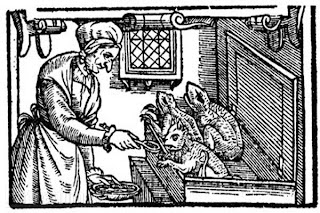 Funnily enough, it was the printing press (which had just been invented) that led to the outbreak of witch hunting. The first printed texts were bibles or books that involved religion, and strangely many of these books promoted witchcraft and ideas of witches. This was the cause of the irrational witch hunts of the 15th and 16th centuries. Later, books on the subjects of alchemy, astrology and magic came out, making people even more interested in the dark magical world. in 1562, Queen Elizabeth the first passed the Witchcraft Act which acted against "conjuractions inchauntmentes and witchecraftes".
Funnily enough, it was the printing press (which had just been invented) that led to the outbreak of witch hunting. The first printed texts were bibles or books that involved religion, and strangely many of these books promoted witchcraft and ideas of witches. This was the cause of the irrational witch hunts of the 15th and 16th centuries. Later, books on the subjects of alchemy, astrology and magic came out, making people even more interested in the dark magical world. in 1562, Queen Elizabeth the first passed the Witchcraft Act which acted against "conjuractions inchauntmentes and witchecraftes".The Black Plague was an unexplainable phenomenon (at the time) that involved death and destruction. Just as Hitler blamed the Jews, the Europeans blamed the plague on witches. This gave further cause for people to continue witch hunts. They were blamed for the terrible diseases, death of animals, bad harvests, burning houses, and even curdled food.
 Women were often the ones accused of witchery. There were 247 women put on trial, and only 23 men. The woman who were targeted were mostly old, poor, single, widows, or unprotected. With women not having not having any rights, and having to rely on males for almost everything, these types of women didnt have men to rely on. They were expected to make cures for sicknesses as part of their house work. As the witch craze was going on, the Catholic church stated that "those who used herbs for cures did so only through a pact with the devil, either explicit or implicit". Having those herbs in ones home meant the punishment of execution by burning.
Women were often the ones accused of witchery. There were 247 women put on trial, and only 23 men. The woman who were targeted were mostly old, poor, single, widows, or unprotected. With women not having not having any rights, and having to rely on males for almost everything, these types of women didnt have men to rely on. They were expected to make cures for sicknesses as part of their house work. As the witch craze was going on, the Catholic church stated that "those who used herbs for cures did so only through a pact with the devil, either explicit or implicit". Having those herbs in ones home meant the punishment of execution by burning.



